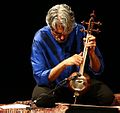Top Qs
Timeline
Chat
Perspective
Kamancheh
Iranian bowed string instrument From Wikipedia, the free encyclopedia
Remove ads
The kamancheh[a] is an Iranian bowed string instrument used in Persian,[1] Azerbaijani,[2] Armenian,[3] Kurdish,[4] Georgian, Turkmen, and Uzbek music with slight variations in the structure of the instrument.[5][6]

The kamancheh is related to the rebab which is the historical ancestor of the kamancheh and the bowed Byzantine lyra.[7] The strings are played with a variable-tension bow.
In 2017, the art of crafting and playing with Kamantcheh/Kamancha was included into the UNESCO Intangible Cultural Heritage Lists of Iran and Azerbaijan.[8]
Remove ads
Name and etymology
The word "kamancheh" means "little bow" in Persian (kæman, bow, and -cheh, diminutive).[9] The Turkish word kemençe is borrowed from Persian, with the pronunciation adapted to Turkish phonology.
It also denotes a bowed string instrument, but the Turkish version differs significantly in structure and sound from the Persian kamancheh.
There is also an instrument called kabak kemane literally "pumpkin-shaped bow instrument" used in Turkish music which is only slightly different from the Iranian kamancheh.[10]
Remove ads
Structure
Summarize
Perspective
The kamancheh has a long neck including the fingerboard, which the kamancheh maker shapes as a truncated inverse cone for easy bow movement in the down section, pegbox in both sides of which four pegs are placed, and finial[11] Traditionally kamanchehs had three silk strings, but modern instruments have four metal strings.
Kamanchehs may have highly ornate inlays and elaborately carved ivory tuning pegs.
The body has a long upper neck and a lower bowl-shaped resonating chamber made from a gourd or wood, usually covered with a membrane made from the skin of a lamb, goat or sometimes a fish, on which the bridge is set.
From the bottom protrudes a spike to support the kamancheh while it is being played, hence in English, the instrument is sometimes called the spiked fiddle.[citation needed]
It is played sitting down held like a cello though it is about the length of a viola. The end-pin can rest on the knee or thigh while the player is seated in a chair.[6]
Kamancheh is usually tuned like an ordinary violin (G, D, A, E).
- Kamancha in an Armenian miniature, XVI or XVII century.
- Qajar Iran miniature of a woman playing the kamancheh.
- A woman playing the kamancheh. Detail from a wall painting in which Mohammad Ali Shah Qajar is surrounded by musicians and dancers. Painted by Abuʾl-Qasim, dated 1816.[12]
- Woman playing kamancheh, ca. 1820.
- The Armenian ashugh Sayat-Nova playing a kamanacheh, ca. 1964.
- Azerbaijani kamancheh player Malik Mansurov.
- Kamancheh player, Kermanshah, Iran, 2008.
- Kamancha player, Yerevan.
Remove ads
Notable kamancheh players
- Habil Aliyev
- Mehdi Bagheri
- Ali-Asghar Bahari
- Mark Eliyahu
- Kayhan Kalhor
- Ardeshir Kamkar
- Kourosh Babaei
- Sayat-Nova
- Mostafa Taleb
- Yaara Beeri
- Mehrnam Rastegari
See also
Notes
References
Further reading
External links
Wikiwand - on
Seamless Wikipedia browsing. On steroids.
Remove ads










